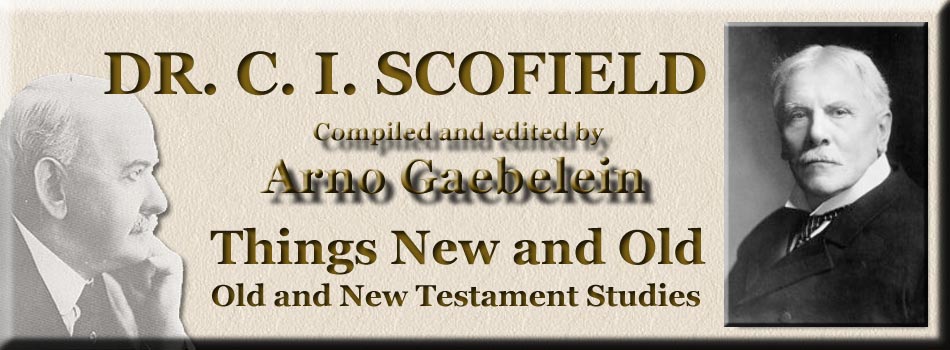
Things New and Old
By Cyrus Ingerson Scofield
Compiled and Edited By Arno Clement Gaebelein
Old Testament Studies
THE SUFFERING SAVIOUR.(Isaiah lii:13— liii:12.) I. The Analysis.1. Christ's ultimate triumph (lii:13-15). 2. The rejected Christ (liii:1-3). 3. The suffering substitute (liii:4-6). 4. The resignation of the sufferer (liii:7-9). 5. God's victorious purpose. II. The Heart of the Lesson.As to the whole meaning of this great chapter there is, of course, no controversy. It is the great atonement chapter. It is to the prophetic part of the Old Testament what the i6thof Leviticus is to the typical part. In the i6th of Leviticus we have, so to speak, the anatomy of atonement, in the 52d and 53d of Isaiah the philosophy of the atonement. As both chapters are expressly appropriated in the New Testament to Christ (Heb. ix:7-12; Acts viii:32-35), it follows that any theory of the atonement which claims to be Scriptural must gather into itself the teachings of both. Our lesson, however, requires us to look at but one of these two great chapters. It seems to me that the heart of things here is three-fold. 1. The sufferings of Christ in atonement were substitutional, vicarious. He died, not as a piteous spectacle, with intent to produce by his agonies a subjective moral influence on human hearts, though surely the fact that we, like the brutal Roman soldiers, can apathetically "watch him there" (Matt, xxvii:36), is the final proof of our depravity. Nor did he die as a martyr, immolated in a great cause. He was under no necessity of death so far as human power was concerned. Of his lie he said, "I lay it down of myself, no man taketh it from me." When the traitor-led crowd came out against him into the garden, he had but to say the dread, "I AM," and they "went backward and fell to the ground." More than twelve legions of angels were ready to deliver him. There is but one explanation of the death of Christ which satisfies the Scriptures: "He was wounded for our transgressions, he was bruised for our iniquities; the chastisement of our peace was upon him; and with his stripes we are healed. All we like sheep have gone astray; we have turned every one to his own way; and the Lord hath laid on him the iniquity of us all." "For he hath made him to be sin for us, who knew no sin; that we might be made the righteousness of God in him." "Who his own self bore our sins in his own body on the tree that we, being dead to sins, might be made the righteousness of God in him." "Christ hath redeemed us from the curse of the law, being made a curse for us." 2. The sufferings of Christ in atonement were not chiefly physical, but spiritual. His soul was made an offering for sin. The soul is the seat of the affections, desires, will. Yet in the death of Christ we see the sufferings of the only man who ever loved God perfectly; whose whole desire was the father's pleasing and who could say of himself, "Lo, I came to do thy will, O God." But his holy soul was made an offering for sin. No man could have done that. Inevitably it must be written, "It pleased the Lord to bruise him; he hath put him to grief." The token of this was Christ's desolate cry from the cross: ''My God, My God, why hast thou forsaken me?" Put the emphasis hard on the "thou," and the "me." Why, indeed, should the only perfectly holy, perfectly obedient Servant whom the Father ever had on earth be forsaken of God in his utmost need? The answer, and there can be but one, is that the Holy One was in that dread hour the sinner's substitute. 3. The sufferings of Christ were germinant. Death pangs, indeed, they were also birth pangs. The anguish of his death was that we might never "taste" death (though we may die), and therefore true death agonies; but the anguish was also the anguish of our new birth. It was the "Travail of his soul." The corn of wheat had fallen into the ground and was dying that the life of it might pass into countless corns of the wheat of God.
|
|
 |
 |
|
|
|
-
Site Navigation
 Home
Home What's New
What's New Bible
Bible Photos
Photos Hiking
Hiking E-Books
E-Books Genealogy
Genealogy Profile
Free Plug-ins You May Need
Profile
Free Plug-ins You May Need
 Get Java
Get Java.png) Get Flash
Get Flash Get 7-Zip
Get 7-Zip Get Acrobat Reader
Get Acrobat Reader Get TheWORD
Get TheWORD